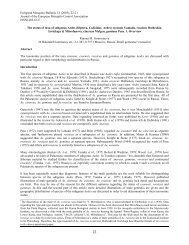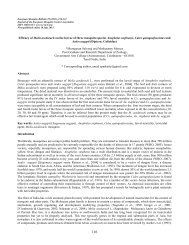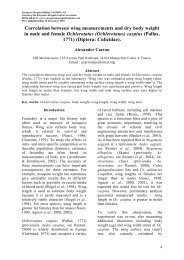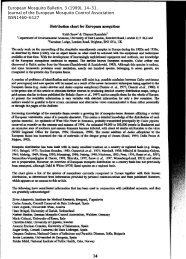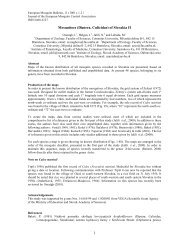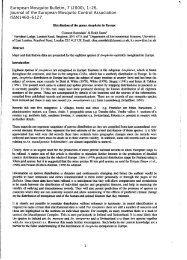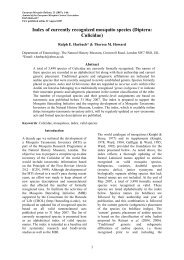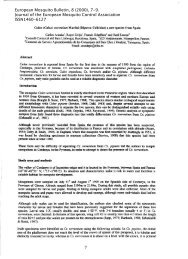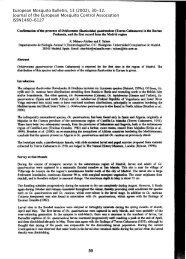The number <strong>of</strong> Cx. <strong>torrentium</strong> individuals caught in 189 CO 2 traps (24) was strikingly lowwhen compared to the number Cx. <strong>pipiens</strong> caught (597 individuals) <strong>and</strong> the species wasobviously under-represented. A possible explanation may lie in the st<strong>and</strong>ardised height <strong>of</strong> onemetre above ground (Becker et al. 2010) being too low for strictly ornithophilic mosquitoeslike Cx. <strong>torrentium</strong>, which probably spend their time around nesting zones (Petric et al. 1999).Similar results were obtained by Küpper et al. (2006) who observed an under-representation<strong>of</strong> the number <strong>of</strong> adults <strong>of</strong> both species when using a different trapping system.Until the 1970s, many authors classified Cx. <strong>torrentium</strong> as rare (e.g. Mohrig, 1969), breedingin clear water in natural breeding sites. Moreover, this species was probably <strong>of</strong>ten neglectedor mistakenly classified as Cx. <strong>pipiens</strong>. Later, Struppe (1989) investigated the speciescomposition <strong>of</strong> larval populations from ovitraps <strong>and</strong> natural breeding sites in different urbanzones <strong>of</strong> West-Berlin (North-Eastern Germany). Based solely on the observation <strong>of</strong> adult malehypopygia, Struppe’s study revealed a proportion <strong>of</strong> 52.65% Cx. <strong>torrentium</strong> <strong>and</strong> 47.35% Cx.<strong>pipiens</strong> out <strong>of</strong> 3833 male specimens analysed. 68.1% <strong>of</strong> Cx. <strong>pipiens</strong> <strong>and</strong> 31.9% Cx. <strong>torrentium</strong>came from natural breeding sites whereas 25.2% Cx. <strong>pipiens</strong> <strong>and</strong> 74.8% Cx. <strong>torrentium</strong> camefrom ovitraps. It remains unclear why such differences are observed, <strong>and</strong> it is uncertainwhether or not one can extrapolate Struppe’s results from Berlin to the rest <strong>of</strong> Germany orother parts <strong>of</strong> Europe.Küpper et al. (2006) recorded twice as many Cx. <strong>torrentium</strong> than Cx. <strong>pipiens</strong> from a larvalsurvey in western-Germany. Similar studies in Engl<strong>and</strong>, (Jupp, 1979) found that 62.1% <strong>of</strong> 206samples were Cx. <strong>torrentium</strong>. Also, from collected egg rafts in southern Engl<strong>and</strong>, Gillies &Gubbins (1982) observed proportions <strong>of</strong> 79.7% <strong>and</strong> 83.6% <strong>of</strong> Cx. <strong>torrentium</strong> from one year toanother. In contrast, only 32.6% <strong>and</strong> 24.7%, respectively, <strong>of</strong> male larvae were identified asCx. <strong>torrentium</strong>. However, the British Isl<strong>and</strong>s may not be representative <strong>of</strong> temperatecontinental Europe, due to their special postglacial zoogeographic history. It is well known,that Cx. <strong>torrentium</strong> is ubiquitous in northern Europe (Utrio, 1976, Dahl, 1988, Hesson et al.,2010). In France, <strong>Culex</strong> <strong>torrentium</strong> has been reported in the Pyrenees around 1500m altitudein swampy fields (Sicart, 1954). Moreover, in 1960, Doby & Rault found this species“extremely usual/common” as it was easily sampled in ‘Haute-Savoie’ from a few hundredmeters <strong>of</strong> altitude. More recently, Schaffner (1998) reported the species as being present inFrance <strong>and</strong> Wegner (2009) found Cx. <strong>torrentium</strong> larvae in central Pol<strong>and</strong>. Identifications <strong>of</strong>460 Cx. <strong>pipiens</strong> <strong>and</strong> 321 Cx. <strong>torrentium</strong> were made in a study covering a wide area <strong>of</strong>European Russia (Vinogradova et al., 2007). Both species were detected even at latitudesabove 60°N. However, Cx. <strong>torrentium</strong> was found to be frequent <strong>and</strong> widespread at latitudesabove 50° suggesting that it is ubiquitous at northern rather than southern latitudes.In the present study, investigations <strong>of</strong> mosquito samples from other European countries foundno Cx. <strong>torrentium</strong> were at latitudes below 48°N, where Cx. <strong>pipiens</strong> predominated.Nevertheless Cx. <strong>torrentium</strong> has already been described in several Mediterranean countriessuch as in Italy (Urbanelli et al., 1981) <strong>and</strong> Spain (Ar<strong>and</strong>a et al., 1999). In Turkey, Parrish(1959) found this species only in coastal regions whereas Cx. <strong>pipiens</strong> was widespread.Nicolescu (1998) found both species in the south <strong>of</strong> Romania. In contrast, in the species chart<strong>of</strong> Snow & Ramsdale (1999) Cx. <strong>torrentium</strong> is missing in Bulgaria, Greece, Turkey <strong>and</strong>Mediterranean isl<strong>and</strong>s. Thus it was not likely to be detected by a few hundreds <strong>of</strong> samplescollected at low altitudes in the present study. Nevertheless the allozyme marker systemwould be valid for discrimination <strong>of</strong> Mediterranean Cx. <strong>torrentium</strong> from Cx. <strong>pipiens</strong> s.l.<strong>Culex</strong> quinquefasciatus has not been collected in Greece, Turkey <strong>and</strong> Cyprus (Snow &Ramsdale, 1999; Simsek, 2003). However, Violaris et al. (2009) stated that Cx. <strong>torrentium</strong>31
<strong>and</strong> Cx. quinquefasciatus are absent from Turkey <strong>and</strong> Cyprus, but reported Cx. <strong>pipiens</strong> to beabundant.Success <strong>and</strong> practicability <strong>of</strong> allozyme technique for species diagnosisSpecies diagnostic allele distribution was successfully used for species identification on alarge scale. In this study, AK <strong>and</strong> HBDH allozymes were used in combination to increase theconfidence <strong>of</strong> species identification up to 99.99%. However, the genotype-combination AK-78/100 is the exception as it does not discriminate between Cx. <strong>pipiens</strong> <strong>and</strong> Cx. <strong>torrentium</strong>;but this would only occur at an extremely low percentage (below 1%, see appendix). Becausethe probability <strong>of</strong> finding this genotype in a sampled population is very low, the allozymetechnique is adequate for <strong>Culex</strong> species identification. As a matter <strong>of</strong> fact, two specimens out<strong>of</strong> 4040 (0.05%) possessed the rare genotype AK-78/100 in combination with a weak HBDHstaining reaction, so that only two samples remained unidentified.In addition to their high reliability, both marker systems were shown by Weitzel et al. (2009)to be diagnostic also for Cx. <strong>torrentium</strong> versus Cx. <strong>pipiens</strong> biotype molestus, Cx.quinquefasciatus, Cx. modestus, Cx. territans <strong>and</strong> Cx. stigmatosoma <strong>and</strong> vice versa.Generally, the allozyme technique can be applied to most kinds <strong>of</strong> organisms. The reliability<strong>of</strong> marker systems is obvious by their b<strong>and</strong>ing pattern, <strong>and</strong> is guided by the use <strong>of</strong> referencesamples. The inheritance <strong>of</strong> cytoplasmic enzyme-genes follows Mendelian rules. The allelecombinations (genotypes) are usually readable in the b<strong>and</strong>ing pattern. Accordingly, theHardy-Weinberg equilibrium gives a guideline for the data structure. Thous<strong>and</strong>s <strong>of</strong> base pairs<strong>of</strong> encoding DNA are represented by only a dozen enzyme loci. In case <strong>of</strong> doubt, a sample canbe checked by other differentiated enzyme loci as was demonstrated in this study. Thetechnique is cheap, easy to apply <strong>and</strong> the chemicals are easily available. No toxic substancesare needed, no toxic waste is produced <strong>and</strong> no radiation is emitted. The material costs fordetermination <strong>of</strong> one sample is about 0.30 €, far lower than for a PCR sample. In one day, 88samples were identified using both AK <strong>and</strong> HBDH marker systems with 44 samples per gel.A higher efficiency is possible, especially when only AK is used <strong>and</strong> in consequence a 1%portion <strong>of</strong> junk is acceptable. This procedure allows huge sample sizes. For each run in thinagarose gels, about 10% <strong>of</strong> the body <strong>of</strong> a mosquito is needed, thus in vector studies thesamples can be divided <strong>and</strong> one part <strong>of</strong> the mosquitoes used for electrophoresis, the other partfor further processing. The preparation process <strong>and</strong> conduction <strong>of</strong> the protein electrophoresisinvolves common laboratory practice easily performed by a technician or a student. In the lastdecades the technique has been optimized to a higher degree <strong>of</strong> efficiency <strong>and</strong> the dataevaluation computerized. A large amount <strong>of</strong> data is available for comparison.AcknowledgementsThanks are due to the German Mosquito Control Association (GMCA/KABS) <strong>and</strong>Gesellschaft zur Förderung der Stechmückenbekämpfung (GFS) for financial support. We arevery grateful to Matthias Beck (Germany, USA), Wolf-Peter Pfitzner, Achim Kaiser <strong>and</strong>Andreas Arnold (Germany), Marija Zgomba <strong>and</strong> Duşan Petrić, University <strong>of</strong> Novi Sad,Serbia, <strong>and</strong> Delphine Rey <strong>and</strong> Rémi Foussadier, EID Rhône Alpes, France for the collection<strong>of</strong> mosquito samples. Specimens <strong>of</strong> Cx quinquefasciatus from Malaysia <strong>and</strong> Indonesia wereprovided by Bayer CropScience, Monheim, Germany. We thank Klaus H<strong>of</strong>fmann <strong>and</strong> KerstinPietsch for technical assistance.ReferencesAr<strong>and</strong>a, C., Eritja, R., Schaffner, F. & Escosa, R. (2000) <strong>Culex</strong> (<strong>Culex</strong>) <strong>torrentium</strong> Martini(Diptera, Culicidae) a new species from Spain. European Mosquito Bulletin 8, 7-9.32



